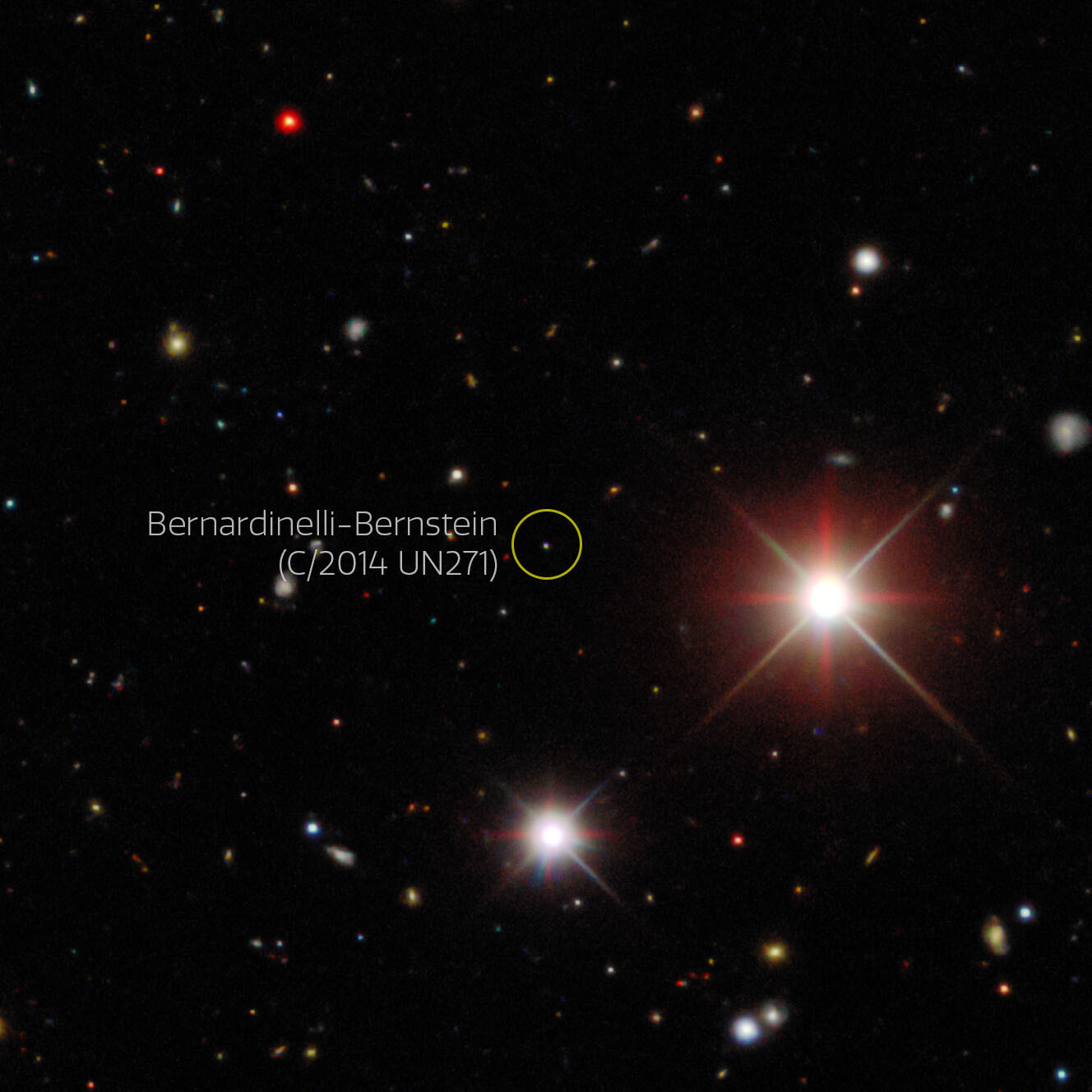NOIRLab: Giant Comet Found in Outer Solar System by Dark Energy Survey

This image from the Dark Energy Survey (DES) is composed of some of the discovery exposures showing Comet Bernardinelli-Bernstein collected by the 570-megapixel Dark Energy Camera (DECam) mounted on the Víctor M. Blanco 4-meter Telescope at Cerro Tololo Inter-American Observatory (CTIO) in Chile. These images show the comet in October 2017, when it was 25 au away, 83% of the distance to Neptune. Credit: Dark Energy Survey/DOE/FNAL/DECam/CTIO/NOIRLab/NSF/AURA/P. Bernardinelli & G. Bernstein (UPenn)/DESI Legacy Imaging Surveys
Acknowledgments: T.A. Rector (University of Alaska Anchorage/NSF’s NOIRLab), M. Zamani (NSF’s NOIRLab) & J. Miller (NSF’s NOIRLab)
A giant comet from the outskirts of our Solar System has been discovered in 6 years of data from the Dark Energy Survey. Comet Bernardinelli-Bernstein is estimated to be about 1000 times more massive than a typical comet, making it arguably the largest comet discovered in modern times. It has an extremely elongated orbit, journeying inward from the distant Oort Cloud over millions of years. It is the most distant comet to be discovered on its incoming path, giving us years to watch it evolve as it approaches the Sun, though it’s not predicted to become a naked-eye spectacle.
A giant comet has been discovered by two astronomers following a comprehensive search of data from the Dark Energy Survey (DES). The comet, which is estimated to be 100–200 kilometers across, or about 10 times the diameter of most comets, is an icy relic flung out of the Solar System by the migrating giant planets in the early history of the Solar System. This comet is quite unlike any other seen before and the huge size estimate is based on how much sunlight it reflects.
Pedro Bernardinelli and Gary Bernstein, of the University of Pennsylvania, found the comet — named Comet Bernardinelli-Bernstein (with the designation C/2014 UN271) — hidden among data collected by the 570-megapixel Dark Energy Camera (DECam) mounted on the Víctor M. Blanco 4-meter Telescope at Cerro Tololo Inter-American Observatory (CTIO) in Chile. The analysis of data from the Dark Energy Survey is supported by the Department of Energy (DOE) and the National Science Foundation (NSF), and the DECam science archive is curated by the Community Science and Data Center (CSDC) at NSF’s NOIRLab. CTIO and CSDC are Programs of NOIRLab.
One of the highest-performance, wide-field CCD imagers in the world, DECam was designed specifically for the DES and operated by the DOE and NSF between 2013 and 2019. DECam was funded by the DOE and was built and tested at DOE’s Fermilab. At present DECam is used for programs covering a huge range of science.
DES was tasked with mapping 300 million galaxies across a 5000-square-degree area of the night sky, but during its six years of observations it also observed many comets and trans-Neptunian objects passing through the surveyed field. A trans-Neptunian object, or TNO, is an icy body that resides in our Solar System beyond the orbit of Neptune.
Bernardinelli and Bernstein used 15–20 million CPU hours at the National Center for Supercomputing Applications and Fermilab, employing sophisticated identification and tracking algorithms to identify over 800 individual TNOs from among the more than 16 billion individual sources detected in 80,000 exposures taken as part of the DES. Thirty-two of those detections belonged to one object in particular — C/2014 UN271.
Comets are icy bodies that evaporate as they approach the warmth of the Sun, growing their coma and tails. The DES images of the object in 2014–2018 did not show a typical comet tail, but within a day of the announcement of its discovery via the Minor Planet Center, astronomers using the Las Cumbres Observatorynetwork took fresh images of Comet Bernardinelli-Bernstein which revealed that it has grown a coma in the past 3 years, making it officially a comet.
